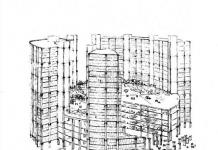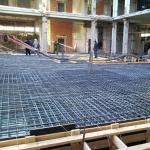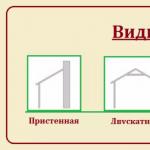Construction is not an easy task... It is not enough to simply pour a foundation and build walls on the site you like. You also need to know how to do this, following a certain order.
So, let's look at the main stages of building an apartment building.
Stage 1 – selection of land.
When choosing a plot of land for development, builders are guided by a number of rules.
- A prerequisite for the construction of an apartment building is the presence of developed infrastructure. The close proximity to the central areas will significantly increase the cost of land, and it will be more difficult to obtain construction permission from local authorities, but as a result, many will want to spend money on an apartment in this particular building. The price per square meter in such a house will justify all the efforts and costs invested.
- Proximity to power supply networks and availability of telephone cables.
- Distance to the nearest water supply pipes.
Stage 2 – approval of the urban development plan.
It is always easier to obtain a building permit on a site that is not yet densely built up with high-rise buildings. If the project is designed for the central area of the city, then you may encounter a number of questions or prohibitions. In this case, you will have to be patient and prove to everyone that your project is the most necessary and necessary.
Stage 3 – geology and topography.
Topographic survey of the future construction site is necessary to obtain the exact coordinates of the object being built and to obtain the main characteristics of the local landscape. These procedures will help determine how deep the groundwater is in this place; the safety of the constructed building depends on this. The general condition of the soil will help determine the degree of possible foundation shrinkage. Based on geological research data, construction technology and the choice of building materials are determined.
Stage 4 – design.
How comfortable life will be in new apartments, their appearance and total area depends on the level of professionalism of the designer. More than one person does this type of work. All company specialists require special permission. In their actions, architects and designers rely on the standards and sanitary requirements adopted in construction. At this stage, everything is taken into account: from the seismological situation to the climatic features of the area.
The complexity of the design lies in the fact that the project not only must meet the customer’s requirements, it must also be approved by the city’s architectural and construction authorities. Some of them will definitely have questions and complaints about the project. To this end, a wise architect will have in his arsenal several blanks for the façade of a building or other parts of the plan.
Stage 5 – construction.
This stage becomes the most noticeable for those around you, and very important for future residents. Before starting construction work, contractors need to win a tender to implement the project.
The most competent and qualified builders will be entrusted with the construction of the facility. Typically, a contractor is selected on a competitive basis, which takes into account work experience, qualifications of employees and the availability of construction equipment.
The construction stage, in turn, also has its own sequence.
- Prepare the construction site (clearing the area, installing fencing, arranging temporary premises, etc.)
- Mark the axes of the building.
- Excavation
- Work on pouring the foundation.
- Construct the outer walls of the facility.
- Bring communications into the house.
- Roof installation
- Installation of internal partitions
- Install windows.
- Fill the floor.
- Conduct an internal communication system.
- Carry out interior finishing work
- Exterior façade decoration.
Today, many residential buildings involve the placement of offices, shops and salons on the ground floor. Their presence should be provided for during the drafting process.
Stage 6 – arrangement of the territory.
According to urban planning regulations, the developer must plan the development of the area around the house. It has already become a practice to make a playground in the yard. Laying asphalt or tiles in front of the entrance and installing street lighting became mandatory. Arrangement of access roads and creation of parking spaces also falls on the shoulders of the developer.
As you can see, the stages of construction of an apartment building are very difficult. Each stage requires careful attention. Without certain knowledge in construction issues it will be difficult to navigate. Many developers claim that they have to face all the main difficulties at the stage of collecting documents, and the construction itself does not take much time.
In contact with
The construction of a multi-storey residential building today is the main option for solving the housing problem for many developers. The advantage of the technology is that not one, but several families will move into a house, even if the construction is carried out on a small plot of land. Several types of construction are popular: panel, brick, monolithic, monolithic-brick. The choice of type of development is carried out in accordance with soil conditions, seismological conditions, climatic conditions, availability of materials, means and capabilities. Land development with multi-storey buildings is a responsible job that does not allow for ignorance or mistakes and requires strict adherence to all nuances.
Panel construction
The technology developed rapidly at the end of the last century due to the efficiency of all stages of work. The presence of ready-made elements allows you to install houses without any delays; the process is reminiscent of assembling a construction set; the elements are produced in a factory manner.
The conditions for using panel construction have their own characteristics:
- The requirement to carry out mass development in a limited area;
- Sale of finished housing at a price that covers the cost of work;
- Availability of a powerful base of resources and equipment used.
Advice! The construction of a panel high-rise building is impossible without the use of lifting mechanisms and the provision of energy resources.
The scope of application of the technology extends not only to the construction of multi-storey public buildings, but also to private housing construction, where it is necessary to erect a building of 2-4 floors. The technology involves the use of two types of residential buildings: frame and frameless.
Frame buildings also have two construction options: full frame or internal. The first are a spatial frame, the formation of which involves external supports and ribbed panels, and the frame is formed by transverse and longitudinal elements. The second option is a design without supporting column panels. The internal columns act as load-bearing columns, taking on the entire load. The optimal span in this case is 500-600 cm. The longitudinal part of the frame is represented by columns, the pitch of which is no more than 300 cm. The permissible floor height is 280 cm, the crossbar and column elements are combined and connected by welds. The column is covered with I-steel consoles. The height of frame buildings is calculated depending on the purpose of the building.
Main stages of construction

Stages of panel construction:
- Foundation work. The choice of foundation depends on the number of storeys of the building, the type of soil and other nuances. When working with lightweight panels (SIP), lightweight foundations are preferable; when working with heavy reinforced concrete panels, a powerful and recessed foundation is chosen.
- Waterproofing the foundation, treating wooden and metal parts with protective agents, installing the bottom beam.
- Arrangement of the basement, laying the floor of the first floor.
- Arrangement of the frame or installation of the first floor by erecting panel elements, fastening the parts by welding.
- Installation of interfloor ceilings along the perimeter of the floor.
- Insulation, waterproofing of the building.

Important! The construction of all subsequent floors is carried out in the same way as the installation of the first. If there are supposed to be large rooms, the structure is reinforced with high-strength timber.
- Roofing. Work is carried out taking into account the weight load on the panel.
- Installation of windows, doors, roofing.
- Finishing work.
This technology has its advantages and disadvantages; the advantages of a multi-storey panel building are as follows:
- Increased speed of building assembly;
- The ability to reduce the size of the construction site by working “from wheels”, that is, the material is delivered from the manufacturer and immediately installed on the site, without cluttering the construction site;
- Minimum set of instruments and equipment for installation of prefabricated structures.
Disadvantages of panel house construction:
- Low thermal performance in comparison with other materials;
- Insufficient sound insulation;
- The slightest deviations in the technology of connecting joints will lead to the formation of cracks;
- Reduced seismic resistance of panel-type high-rise buildings;
- Dependence of the layout on the panel elements produced (this only applies to large-panel houses).
Construction of brick houses

The technology of brick construction became known a very long time ago; even before our era, people built houses from baked pieces of clay, giving them almost the right size. The technology is simple, reliable, and does not require special equipment other than lifts, but it is difficult to implement and quite labor-intensive. At the same time, brick construction is impossible without experience, knowledge and the use of highly qualified workers. Minimal masonry errors will lead to irreparable loss of appearance, so the brick construction of a multi-story building should either be carried out under constant supervision, or only by the hands of professionals.
Today there are 2 types of bricks used:
- The ceramic piece product has strength, heat resistance, seismic resistance, and moisture resistance. At the same time, brick is easy to manufacture
- Silicate is made from a mixture of lime and sand, has a cheaper price and its characteristics are more modest: it does not tolerate moisture and high temperatures.
Advice! Manufacturers offer a good alternative: hollow (slotted, porous) brick. Due to the voids in the mass, the product has a greater heat capacity and provides better thermal insulation.

Stages of building a brick house:
- Foundation. A powerful, durable and well-buried foundation is required, since the brickwork is massive.
- Foundation waterproofing.
- The first row of masonry is on a “dry” base, then the next rows of masonry are made, and the choice of installation option for bricks is made depending on the features of the project, the height of the house and the customer’s preferences;
- Reinforcing masonry elements or “bundles” must be present in every 2-4 rows;
- Laying of interfloor ceilings is carried out using the slab method;
- Each subsequent floor is laid out, just like the first; we should not forget about tying and strengthening the wall panels.
- Insulation and waterproofing of the building;
- The roof is installed rough, mostly flat. The final roofing is laid only after the structure has settled.
- Installation of windows and doors.
- Final finishing work.
The brick construction of a multi-storey building has a lot of nuances: from the choice of masonry type to the variability of the bond. However, despite the difficulties, the numerous advantages of the final result make up for all the technological inconveniences:
- The highest thermal characteristics;
- The best sound insulation performance;
- Maintaining a comfortable microclimate inside the house;
- Variability of building formats;
- Undemanding façade finishing due to the good aesthetic appearance of exposed brick.
There are several disadvantages:
- Mandatory use of qualified labor;
- High price level for construction work;
- Slow construction of the house;
- Requirement of time for shrinkage;
- Limited number of floors in buildings;
- It is mandatory to have a large warehouse for materials on the construction site.
Monolithic construction

One of the newest technologies is monolithic construction of a residential building. The type of construction is based on pouring a building with concrete mixture directly on the construction site. The cost of the work is high, labor costs are also high, so monolithic panel construction is most often used, where construction is carried out using ready-made monolithic reinforced concrete slabs manufactured in a factory. When considering monolithic technology, it is worth clarifying that all processes are carried out only in seasons with warm temperatures; in case of precipitation, work stops. A detailed plan for the work being carried out is extremely necessary, since any deviation from the process, delay or incorrect choice of cement brand threatens a violation of the technology, as a result of which the developer will receive a fragile house that requires constant modifications.
Construction stages:
- Site preparation, arrangement of a buried foundation;
- Installation of reinforcement frame;
- Installation of formwork;
- Pouring concrete mixture;
- Warming up the concrete for better setting when the ambient temperature drops;
- Dismantling of formwork;
- Arrangement of interfloor ceilings;
- Roof installation;
- Exterior finishing.

Important! Concrete compositions are characterized by high insulation and energy intensity, so the structure will not require additional work on laying hydro-, heat-, and sound insulation. There is no need to additionally level the wall panels, that is, all work comes down to finishing.
Advantages of monolithic construction:
- Open plan;
- Individuality of building configuration;
- Smoothness of all wall and ceiling panels, which reduces the finishing stage to a minimum;
- Increased seismic resistance of buildings.
Disadvantages of monolithic construction:
- Use of highly qualified labor;
- High cost of building construction;
- Low use of technology.
Important! It is worth noting that monolithic construction technology is in little demand in today’s market, however, numerous advantages make it possible to use this type of house construction on a wide variety of soils. And if you use the panel-monolithic option, the buildings meet the highest demands and requirements of the owners, distinguished by durability, practicality, long service life and excellent heat and power performance.
Monolithic brick construction

Frame-monolithic construction technology has become widespread. Being the most modern option, the type of construction is reliable and allows you to combine in one object all the indicators of a heat- and soundproof brick wall with the variability of planning solutions for a building using monolithic reinforced concrete floors. The price level of buildings lies between inexpensive large-panel technology and expensive brick houses.
The construction stages are similar to other technologies:
- Arrangement of a strong foundation;
- Installation of the house frame with pouring concrete, after which the formwork is removed and the process is repeated until the building reaches the required height;
- Installation of interfloor ceilings;
- Construction of the next floors;
- Arrangement of a rough-type roof, and after shrinkage of the structure, installation of a finishing roof;
- Finishing work.
Advantages of monolithic brick construction:
- The most modern technology that allows you to quickly erect buildings of different heights, shapes, and formats;
- Open plan;
- High thermal capacity and sound insulation: such a high-rise building combines all the unique qualities of brick and concrete;
- Minimum requirements for the alignment of walls and ceilings, which means easier finishing work.
A monolithic brick apartment building will have one drawback - mandatory compliance with development technology, and, consequently, the use of highly qualified workers.
Monolithic ventilated facades

Strictly speaking, this is not a construction technology, but rather a type of finishing work. The systems are characterized by the following indicators:
- The presence of an air gap between the wall surface and the finish;
- Possibility of using different types of cladding panels;
- Adding aesthetics to the facade and minimizing the threat of condensation in the house;
- Significant reduction in heating costs due to increased heat capacity of the entire building.
This technology is used for many multi-storey buildings for various purposes. At the same time, the materials used for the installation of ventilated facades are produced in a huge variety: aluminum, vinyl panels or panel elements made of composite materials are durable and strong.
When choosing a suitable technology for the construction of multi-storey buildings, it is necessary to take into account not only all economic aspects, but also the availability of a powerful base of special equipment, resources and professional builders. It is difficult to cope with a house even of 2-3 floors alone; it is better to entrust this task to specialists.
Construction of an apartment building, at first glance, is not the most difficult task and at the same time very standardized - choosing a plot of land, constructing a foundation, erecting walls and subsequent finishing. However, in fact, building a house is a process that has many nuances, especially when it comes to building a multi-story building with a hundred or more apartments.
Let's consider the main stages of construction of an apartment building.
Stage 1. Selection of land
Selecting the most suitable land plot for construction is perhaps one of the most important stages of construction. When choosing, the following factors are taken into account:
1. Availability of all necessary communications, proximity to thermal and electrical networks, telephone cables. Since most modern residential buildings have autonomous heating, the proximity of the central heating main is not any determining factor. While the need to “stretch” water supply pipes or erect supports for laying power lines can significantly increase the cost of construction.
2. Proximity of city infrastructure facilities. The closer the new building is to the city center, the more attractive it looks in the eyes of future residents. But there are also disadvantages. Land in the central areas of the city is very expensive, and therefore the cost per square meter will be rather high. In addition, it is extremely difficult to obtain permission to build in such areas from the authorities. On the contrary, the cost of apartments in houses located on the outskirts of the city or outside it will be much lower, but it is not a fact that transport links to such areas will be convenient and regular.
We also note that the construction of any multi-storey buildings, including apartment buildings, is carried out according to the urban plan. To begin construction of a facility, especially in the central area of the city, it is necessary to obtain about 50 permits! In areas where there are not yet very many new buildings, and the master plan provides for the construction of several objects, it is easier to obtain permission.
If the customer of the construction is the city authorities, then the process of obtaining a construction permit is also obviously simplified. But in this case, the housing built is often intended for the low-income population (economy class apartments).
Stage 2. Topographic survey and geological examination of the land plot
On the site intended for construction, it is necessary to carry out topographic survey in order to:
- determine the coordinates of the location of the future object;
- identify the characteristics of the surrounding area.
Topographic survey, along with geological surveys, allows you to find out how deep the groundwater is, as well as assess the condition of the soil, the possibility and degree of shrinkage of the foundation of the future structure.
This work is carried out only by organizations that have the appropriate permit. Upon completion of the work, the contractor provides the developer with progress report, which contains the following points:
- relief characteristics;
- soil composition, its physical properties and geological structure;
- climatic and meteorological characteristics, etc.
Conducting geological surveys is necessary for an informed choice of construction technology and building materials. So, if the site has complex terrain or groundwater is too close, special methods will be required.
Stage 3. Design
Designing a multi-storey residential building is an unusually complex and responsible task, because... It is from this stage that not only the size of the area and the convenience of apartment planning, but also the appearance of the building depends.
When developing a project for a future home, we are guided by the following:
- Sanitary requirements;
- Approved building codes;
- Climate features;
- Seismological situation.
For example, sanitary legislation controls compliance with such parameters of residential premises as ventilation and lighting, and the development of a thermal protection system is carried out taking into account the average annual temperature - if necessary, additional insulation of the facade can be provided. Designing a building also involves choosing the optimal way to locate communications, taking into account environmental requirements and environmental characteristics.
The complexity of the design stage lies in the fact that the designer must coordinate the final design of the building with architectural and construction authorities, while strictly observing established sanitary requirements.
When constructing high-rise buildings (more than 22 floors), the expected load on the foundation is carefully calculated and the reliability of load-bearing structures is considered.
Another important detail is that when designing, the architect must take into account not only the features of the territory, but also further plans for the development of this area. Without taking these features into account, in the future you may encounter such “surprises” as a radical change in the view from the windows or the building’s appearance inconsistency with neighboring buildings.
Only a competent, repeatedly tested project that meets all requirements guarantees that the result of construction will be a safe, reliable and visually attractive apartment building, which will be a wonderful place to live and relax.
Few people know what stages of construction of an apartment building precede the emergence of new “giants” that provide housing for hundreds, or even thousands, of people. At first glance, the creation of such objects is a simple process, including the preparation of documents, the construction of the building and the subsequent finishing of the apartments. In practice, building a house is a complex process with many nuances and difficulties that the developer has to overcome. Below we will consider the stages of construction of an apartment building and the features of this work.
The first step is to find a suitable site for the construction of a new facility. When choosing, the developer focuses on two main criteria:
- Proximity to city infrastructure. The best option is to build a residential building closer to the center, where there is everything necessary for a comfortable stay (shops, hospitals, schools, kindergartens and other facilities). But the closer the site is to the central part, the higher the cost of the land, and it is more difficult to obtain permission.
Buying a plot of land outside the city allows you to save money and process documents faster, but difficulties arise with the sale of apartments. People are in no hurry to purchase real estate in places where there is no normal transport connection and no necessary infrastructure. Accordingly, the cost of one “square” of housing is reduced.
- Possibility of communication. The next important point is the proximity of telephone lines, heat supply, electrical and gas networks. If the new building has autonomous heating, the issue of connecting to the central heating main is resolved by itself. At the same time, it is still necessary to draw water to the house, install supports for supplying electricity, connect gas, and so on. All this increases the cost of construction and complicates the project.
The next “stumbling block” is the urban planning plan, taking into account which the city is being developed. Construction companies have to go through real “circles of hell” to get approval for the construction of a multi-storey building, and the total number of permits when constructing a facility near the city center can amount to several dozen.
The easiest way is to obtain a building permit in an area where there are still few new buildings, and the master plan provides for the construction of several houses. The process of obtaining a permit is also simplified when municipal authorities act as the customer for the construction. But here we are talking about multi-storey buildings with economy-class apartments intended for low-income families.
Carrying out topographic survey and geological examination

At the next stage of construction, a topographic survey is carried out, thanks to which it is possible to solve two issues - to accurately determine the coordinates of the location of the future multi-apartment residential building, as well as the characteristics of the area. In addition, conducting a topographic survey is an opportunity to find out the depth of groundwater, as well as assess the quality of the land plot, the likelihood of soil shrinkage after laying the foundation and the reality of the construction of the facility as a whole.
Carrying out geological examination and topographic survey - work that involves companies with special permission. Upon completion of the activities, employees of such an organization submit a report to the developer. The document reflects the following information:
- Soil composition, its geological structure and physical characteristics.
- Features of the terrain.
- Meteorological and climatic parameters.
- Other data on the land plot.
Carrying out the measures considered allows us to accurately determine the technology for constructing the facility, as well as choose the right building materials. If the groundwater on the land is at great depth or there is complex terrain, the use of special construction techniques is required.
Design
After topographic survey and geological examination, you can proceed to the next stage - drawing up a project for a future apartment building. The future layout of the apartments, the size of the living space, as well as the appearance of the property depend on the correctness of its implementation.
The project of the future house is developed taking into account current building codes, climatic conditions, sanitary requirements and the seismological situation. For example, in sanitary legislation, key attention is paid to the quality of ventilation and lighting. As for thermal insulation, the need for additional finishing of the facade will be determined taking into account the average annual temperature.
When developing a project, many factors are taken into account, including the location of communications. Here, developers of project documentation have to take into account many requirements (including in the environmental sector), as well as environmental features.
The main difficulty in developing a project is the need to coordinate it with architectural and construction organizations. It is this stage that takes the “lion’s” share of time.
If an apartment building has a height of 22 floors or more, an additional calculation of the load on the foundation and determination of the resistance of load-bearing elements is required. When creating a project, specialists must take into account the characteristics of not only the territory where construction is taking place, but also the development plan for nearby areas.
The result of the construction of an apartment building, its reliability, safety and external attractiveness depend on the correctness of the drafting of the project, as well as checking the documents for compliance with the requirements. A project declaration must be drawn up, which provides information about the developer and the facility.
Construction

The actual construction of a residential multi-storey building takes place in several stages. Let's look at these stages in detail:
Preparing the site for construction
The developer carries out preliminary work that allows the construction of the facility to begin. This includes fencing the area to prevent entry by unauthorized persons, clearing the land area of trees, structures or buildings (if any), as well as re-equipping utility networks that interfere with construction activities.
At the same stage, the developer organizes routes for transport access, thinks through the nuances of laying communications, provides systems for protection from rainwater, and installs household and administrative premises.
Marking the axes of the house
This stage of construction is extremely important and requires accurate calculations, as well as careful verification of the results obtained. Even small deviations can lead to a number of consequences that cannot be corrected. In the marking process, new types of measuring instruments are used, which are highly accurate.
Excavation
A special feature of this stage is the preparation of the pit for subsequent laying of the foundation. Work is also underway to create trenches for supplying communications. When constructing an apartment building with a large number of floors, the volume of earthworks is large, so special equipment is used - excavators and bulldozers.
Laying the foundation
At the heart of any multi-storey structure is a foundation, the quality of which determines the reliability, strength and, accordingly, the lifespan of the finished building. The base takes on the greatest load, so when drawing up a project, maximum attention is paid to it.
The type of foundation used depends on the soil. For example, when constructing a multi-story building, it may be necessary to add sand or gravel. The main work at this stage is pouring concrete capable of supporting a high-rise structure.
Construction of external walls
The duration and complexity of this stage depends on the chosen technology. There are plenty of options - erecting a building from brick, using reinforced concrete panels or building using monolithic technology. The latter option is in greatest demand due to its simplicity, reliability and high speed of construction.
Communications supply
As noted above, trenches for communications are prepared at the excavation stage. At this stage, gas, water and electricity supply elements are laid. Work on the supply of sewerage and other utility networks is also carried out here.
Roof arrangement
The volume and complexity of the work depends on the type of roof chosen. Modern multi-storey buildings often have a usable type of roof with the possibility of arranging a winter garden at the top. This, in turn, increases the cost of construction.
Final stages
 At the final stage, the following work is performed:
At the final stage, the following work is performed:
- Creation of internal partitions - dividing the house into apartments, taking into account the previously drawn up project, as well as equipping the building with elevators.
- Installation of windows and installation of metal doors in the apartments of future residents.
- Arrangement of internal communications - installation of electrical wiring, sewerage, water and gas supply systems, installation of water and gas meters.
- Floor screed. During the work process, a sand-concrete composition is used, and after pouring, the surface is leveled.
- Interior finishing can be rough or finishing. Many construction companies sell housing with rough finishing, which allows them to reduce the cost of apartments. If the developer carries out a full scope of work, you can immediately move into the resulting property, but the price will be higher.
- Exterior finishing - facade treatment, as well as renovation of common areas. When selling apartments with rough finishing, common areas (hall, entrance, staircases) must be completely ready for use.
Arrangement of the local area
The last stage of construction involves landscaping the area near the apartment building. This allows you to solve two problems - comply with the requirements of urban planning regulations and attract potential buyers.
The complex of works for arranging the adjacent area includes planting flower beds and greenery, installing a children's playground near the house, laying paving slabs and creating access roads for transport. Street lighting and parking near the building are also being installed. Elite class houses may have underground parking, a swimming pool and other amenities.
Results
From the above it is clear that the construction of an apartment building includes many stages, and the process itself requires a lot of time. Developers note that the greatest difficulties arise at the stage of creating and approving a project, collecting documents and issuing permits. To speed up construction and reduce the final cost of the project, standard designs are often used.
Residential real estate is in demand today in almost any city. Apartment buildings are a priority area of this business. But the construction of a residential building requires significant investments, so investors are often attracted to construction. In general, the business brings in considerable income, but requires serious organizational work.
Required Documentation
First of all, a business plan for the construction of a residential building must provide for the official registration of the developer. Usually the developer is registered as a limited liability company. When registering, the main activity of the LLC is indicated - the construction of residential real estate.
To begin construction of an apartment building, the following documentation is required:
- house construction financing schedule;
- agreed work plan;
- design documentation;
- conclusion on the project, where there should be a visa from the urban planning department and the architectural department of the city administration;
- license for construction and installation work;
- a construction permit, which must be obtained from the city administration;
- a lease or purchase agreement for the land plot on which the house is being built;
- conclusion of the state examination.
This is by no means an exhaustive list of documentation. As a rule, the list includes more than fifty documents, which may differ depending on the region of construction.
Analysis of the real estate market in the region
Despite the fact that the market is experiencing a chronic need for primary housing, there is little competition in this area of construction. This situation is associated with high risks in the construction of residential real estate. Therefore, at the first stage of implementing the idea, it is important to conduct an accurate and detailed analysis of all factors influencing the further implementation of housing.
You need to find out what the residential real estate market is like in the area chosen for construction: what apartments are offered, what status, in what volume and at what price. Try to find out how many square meters were sold over the last year, what the dynamics of sales and construction of new facilities are. Assess how your property will fit into the overall infrastructure of the area.
Assess the purchasing power in the region and the conditions of local banks for mortgage lending. The status of your future apartment building and, accordingly, the price per square meter depend on these data. The price must be justified in detail.
Benefits of working with local authorities
At the stage of forming the goals of the project, it is worth clarifying what housing policy the local administration adheres to. If she participates in government programs for the resettlement of urban residents from emergency housing, she can:
- purchase ready-made real estate;
- invest construction;
- provide information support;
- provide support with documentation.
The last provision is extremely important, since with independent construction, the preparation of documentation can take years.
But in this case, you rarely have to count on the construction of premium-class houses. Typically, authorities are interested in small apartments where residents from emergency housing can be resettled.
Project Implementation Plan
The project is being implemented strictly in stages.
Selection of land
First of all, you need to find out how close the city’s electricity, water and heating networks are located to it. The closer they are, the less money you will have to invest to lay the necessary communications, the less a square meter of your apartments will cost. The same goes for telephone networks and internet provider cables. The latter is one of the main conditions put forward by buyers today.
A big plus for the sale of apartments will be the presence of good transport links, various shopping and cultural centers, kindergartens, clinics, schools, hospitals and other things.
Please note that each city is developing its own urban plan for the next couple of years. It will be much easier to obtain a building permit in those areas where the construction of residential buildings is planned in accordance with it. The ideal option is to receive a government order for the construction of such facilities.
Geological expertise and topography
Before construction begins, exploration work must be carried out, based on the results of which it is determined at what depth the foundation can be laid, what its design features may be, and what materials the house should be built from.
This is determined by the following terrain indicators:
- Climatic and weather conditions.
- Relief of the site and area.
- The depth at which groundwater is located.
- The degree of possible shrinkage of the building.
- Properties and condition of the soil.
This work is carried out by special geological exploration companies.
Preparation of the project project
At this stage, designers, engineers, and designers are involved, who will use the information obtained at the previous stage. They create a project for the appearance of the building, the layout of the apartments, and the surrounding area. At this stage, it is taken into account how the house will fit into the landscape, how well it corresponds to the urban planning plan, and what the view from the apartments of the houses will be like. The latter affects their price.
The plan must indicate:
- number of apartments;
- number of commercial properties;
- number of buildings;
- total living area;
- total commercial area;
- type of building, etc.
Project implementation
Then you need to write down a clear step-by-step schedule for carrying out and delivering the work:
- paperwork;
- preparation of the territory;
- laying the foundation;
- erection of a building;
- conducting communications;
- internal and external finishing works;
- beautification of the territory.
The last point involves laying sidewalks and planting trees and bushes. The more well-groomed the territory of the new house is, the more expensive the apartments in it will be.
Expenses
A 10-story residential building with five entrances will require an average investment of about 300 million rubles. But this figure is very arbitrary, as it depends on a number of factors: from the cost of building materials to the scale and type of the project. Fixed funds will be spent on laying communications, constructing a building and paying staff.
You can invest your own funds or raise funds from investors. The latter may be future residents of the houses who contribute money equal to the cost of their future apartment. All these costs must be reflected in the estimated invoice.
Income
The project's profit comes from the sale of apartments. According to experts, the cost per square meter in an apartment building does not exceed 25 thousand rubles, while the average cost on the market is 35 thousand rubles.
Additional profit can be obtained from leasing or selling commercial space for fitness clubs, health centers, retail establishments, etc. A good profit comes from parking or adjacent garages.
The profitability of the project remains at the level of 10-15%. It will pay off approximately 4 years after the start of construction of the house.


















